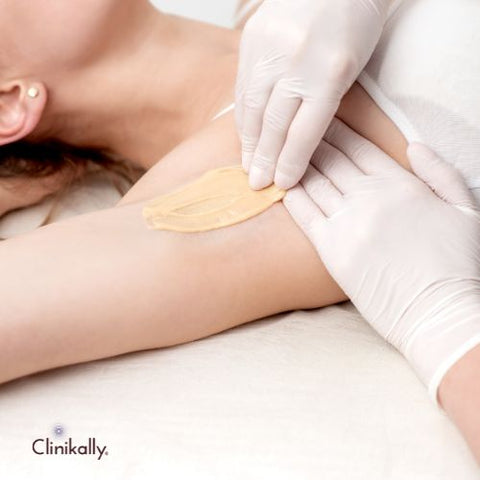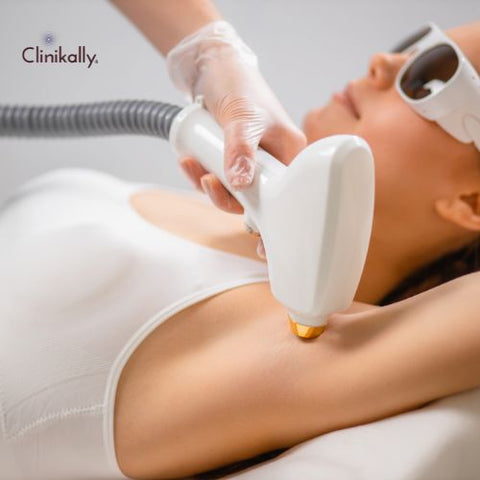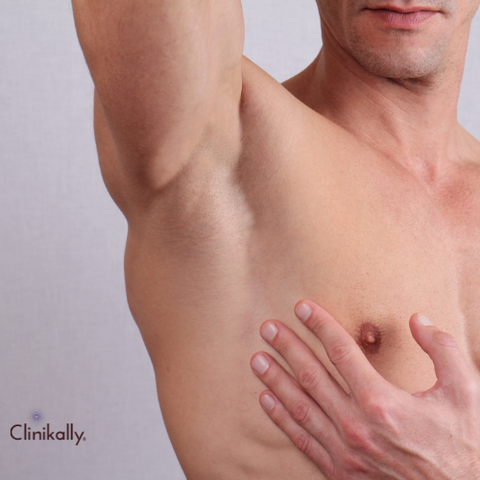Many people are embarrassed and self-conscious about their dark underarms, but there are ways to lighten and brighten the skin in this area. When attempting to lighten dark underarms, it is critical to be patient and consistent. It may take several weeks or even months for results to become visible, and it is critical to continue using gentle, non-irritating products to maintain the results. You can achieve smooth, even skin in the underarm area and feel confident showing off your arms with a little patience and diligence.
Understanding Dark Armpits: Causes and Contributing Factors

Numerous factors, including the following, can contribute to dark armpits, also known as acanthosis nigricans:
-
Friction: Darkening can result from rubbing or chafing of the skin under the arms. Tight clothing, frequent shaving, or excessive perspiration can all contribute to this.
-
Hyperpigmentation: An increase in melanin production may cause the skin under the arms to become darker. Genetics, hormonal changes, or sun exposure are possible causes of this.
-
Poor hygiene: A buildup of bacteria and dead skin cells due to improper hygiene can result in the darkening and discoloration of the skin.
-
Use of certain products: Certain products, such as deodorants, antiperspirants, and hair removal creams, can cause irritation and inflammation, resulting in skin discoloration.
-
Medical conditions: Skin darkening under the arms can be brought on by conditions like diabetes or polycystic ovary syndrome (PCOS).
The Role of Hormones, Genetics, and Ethnicity in Hyperpigmentation
Hormones, genetics, and ethnicity can all play a role in hyperpigmentation, including underarm skin darkening. Hyperpigmentation can be brought on by hormonal changes, such as those that occur during pregnancy, menopause, or as a side effect of some medications. Genetics can also play a role because some people are predisposed to have more melanin in their skin or have a genetic condition that causes hyperpigmentation. Finally, ethnicity can influence the development of hyperpigmentation because those with darker skin tones have more melanin in their skin and are more likely to do so in response to certain stimuli like inflammation, injury, or sun exposure.
The Impact of Hair Removal Methods and Antiperspirants on Underarm Skin
Hair removal methods and antiperspirants can both have an impact on the skin in the underarm area. Hair removal techniques like shaving, waxing, or using creams can irritate and inflame the skin, which over time causes discoloration and darkening. These techniques may also lead to ingrown hairs, which can exacerbate inflammation and discoloration. Antiperspirants contain aluminum compounds that reduce sweating by obstructing sweat glands. Antiperspirants work to reduce sweat and odor, but they can also irritate and inflame the skin, especially if used excessively or on skin that is already broken or irritated. This may cause the skin to become darker, discolored, or even peel or flake.
Antiperspirants should be used sparingly and should not be used too frequently or excessively. Consider gentle methods of hair removal, such as trimming or using an electric razor, and avoid shaving too frequently or using hair removal creams that may be harsh on the skin. Choose antiperspirants labeled "sensitive" or "gentle" and avoid using them immediately after shaving or on broken or irritated skin. Consider stopping antiperspirants entirely to allow the skin in the underarm area to breathe and recover.
Effective Techniques for Exfoliation and Hair Removal

There are a number of efficient methods for exfoliation and hair removal that can help to enhance the look and health of the skin around the underarm region.
Exfoliation:
-
Chemical exfoliation: This method uses products containing retinoids, enzymes, or alpha- or beta-hydroxy acids to gently dissolve and remove dead skin cells. This technique can be especially beneficial for people with sensitive skin because it is typically regarded as gentler than physical exfoliation.
-
Physical exfoliation: This involves using a physical scrub or brush to physically remove dead skin cells. Applying too much exfoliation, which can irritate the skin and harm it, should be avoided. Instead, use gentle circular motions.
Hair removal:
-
Shaving: This is a quick and easy method that can be done at home, but if not done correctly, it can cause irritation, ingrown hairs, and razor burn. It is critical to shave in the direction of hair growth with a sharp, clean razor.
-
Waxing: Hot wax is applied to the skin, and the wax and hair are removed with a strip. It is more effective than shaving, but it is more painful and can cause irritation and ingrown hairs.
-
Laser hair removal: A laser is used to destroy the hair follicle, preventing future hair growth. It is a more permanent solution, but it is more expensive and may necessitate multiple treatments.
The Benefits of Regular Exfoliation for Brighter, Smoother Underarm Skin
The underarm skin can benefit from regular exfoliation in a number of ways, including:
-
Smoother skin: Exfoliating helps remove dead skin cells that can accumulate on the skin's surface and give it a rough, uneven appearance. Regular exfoliation can encourage softer, more supple skin.
-
Brighter skin: A buildup of dead skin cells, sweat, and debris can result in the underarm skin becoming darker. Exfoliating can help clear up these impurities and make the skin look more radiant.
-
Reduced ingrown hairs: Ingrown hairs in the underarm area can be a common issue, particularly after shaving or waxing. Exfoliating can help prevent ingrown hairs by removing dead skin cells that might obstruct hair follicles.
-
Improved effectiveness of other skincare products: By removing dead skin cells, exfoliation can help other skincare products penetrate the skin more effectively. This implies that the skin will absorb moisturizers and other treatments more effectively, producing better results.
Choosing the Right Hair Removal Methods for Your Skin Type and Concerns
Choosing the right hair removal method for your skin type and concerns is important in order to avoid irritation, ingrown hairs, and other problems. Here are some recommendations for picking the best hair removal technique:
-
Hair removal by shaving is quick and simple, but it can irritate skin and result in razor burn and ingrown hairs. If you decide to shave, use a razor that is clean, sharp, and move in the direction of hair growth. To lubricate the skin and lessen irritation, use shaving cream or gel.
-
Waxing can produce longer-lasting results because it removes hair from the root. Waxing, however, can be uncomfortable and result in ingrown hairs and irritation. If you have delicate skin, either stay away from waxing or use a gentle waxing formula. Waxing shouldn't be done over any skin damage, including burns, cuts, or other wounds.
-
Depilatory creams disintegrate hair at the skin's surface, making them a good choice for people with sensitive skin or those who want to avoid razor burn. Depilatory creams, however, can be harsh and irritate people or trigger allergic reactions. Make sure to select a product that is made especially for use on the underarm region.
-
Laser hair removal can be an effective long-term hair removal solution, but it can be expensive and may not be suitable for all skin types. Laser hair removal may not be effective on blonde or gray hair because it targets the pigment in the hair follicle. It's crucial to pick a trustworthy provider and to adhere to all pre- and post-treatment instructions.
-
Electrolysis is another long-term hair removal solution that works by destroying the hair follicle with an electrical current. For those with darker skin tones or who are ineligible for laser hair removal, electrolysis can be an effective alternative even though it can be time-consuming and uncomfortable.
How to Minimize Skin Irritation and Damage from Shaving, Waxing, and Other Methods
The following advice will help you reduce skin sensitivity and harm caused by hair removal techniques like shaving, waxing, and depilatory creams:
-
Prepare your skin: Thoroughly clean the area to get rid of any dirt, oil, or bacteria before shaving. Use warm water and a mild cleanser before shaving to soften hair and widen pores. Use of lotions, oils, or other products that may interfere with the wax should be avoided when waxing.
-
Utilize the proper products: Shave with a shaving cream or gel to lubricate the skin and lessen friction. Pick a waxing formula that is gentle and intended to be applied to delicate areas. Make sure to select a depilatory cream that is made specifically for use on the underarm region if you use one.
-
Apply the proper technique: Shave in the direction of hair growth while using a razor that is clean and sharp. Avoid applying excessive pressure because this can lead to irritability and cuts. When waxing, quickly remove the wax in the opposite direction from the direction in which the hair grows.
-
Be gentle: Avoid rubbing the skin harshly, as this can irritate it and harm it. Instead, exfoliate and remove dead skin cells by massaging in gentle, circular motions.
-
Moisturize: After shaving or waxing, apply moisturizer to the skin to hydrate and calm it. Use a gentle, fragrance-free moisturizer to avoid further irritation.
-
Avoid wearing tight clothing: Particularly after hair removal, tight clothing can rub against the skin and irritate it more. Choose loose, breathable clothing to avoid this.
-
Avoid sun exposure: To prevent additional irritability and damage, wait at least 24 hours after shaving or waxing before going outside in the sun. To shield the skin from UV rays, use broad-spectrum sunscreen with an SPF of 30 or higher.
By following these recommendations, you can keep your underarm skin supple and healthy while reducing skin sensitivity and damage brought on by hair removal procedures.
Professional Treatment Options for Skin Discoloration

If over-the-counter medications or at-home remedies don't work to reduce your skin discoloration, think about seeking professional help. The following are some alternatives that a dermatologist might suggest:
-
Chemical peels: When a chemical solution is applied to the skin, the top layer of the skin begins to peel off. This can encourage the growth of new skin cells, which can help to improve the appearance of skin discoloration.
-
Laser therapy: Laser therapy targets and eliminates skin-pigmented cells by means of concentrated light beams. This may be particularly effective for people with darker skin tones and may help lessen the appearance of skin discoloration.
-
Intense pulsed light (IPL) therapy: IPL therapy uses pulses of light to target the melanin in the skin, which can help reduce the appearance of skin discoloration. It works particularly well on age spots and sun damage.
-
Microneedling: Microneedling is the process of puncturing the skin with very small needles using a device. This can enhance the appearance of skin discoloration and encourage the production of collagen.
-
Topical prescription medications: Your dermatologist may recommend prescription-strength topical medications, such as hydroquinone, retinoids, or corticosteroids, to help reduce the appearance of skin discoloration.
The Effectiveness of Chemical Peels, Laser Treatments, and Other Medical Procedures
Depending on the reason for the discoloration and how severe it is, chemical peels, laser treatments, and other medical procedures may be successful in treating it. The following are some advantages and restrictions of these treatments:
-
Chemical peels, which remove the top layer of skin and encourage the growth of new skin cells, can help reduce the appearance of skin discoloration. They may be successful in treating melasma, sun damage, and age spots. They may, however, also result in temporary side effects like redness, peeling, and others.
-
Laser treatments use focused beams of light to target and remove pigmented cells in the skin. A variety of skin discolorations, such as age spots, sun damage, and post-inflammatory hyperpigmentation, can be successfully treated with them. However, they may also result in short-term bruising, swelling, and other negative effects.
-
Microneedling can help improve the appearance of skin discoloration by stimulating collagen production and promoting new skin cell growth. It can be effective for treating acne scars, fine lines, and hyperpigmentation. However, it can also result in short-term swelling, redness, and other side effects.
-
Prescription-strength topical medications, such as hydroquinone, retinoids, or corticosteroids, can be effective for treating skin discoloration. They can help even out skin tone and lighten dark spots. They may, however, also result in other side effects, such as skin irritation. It may take several weeks or months of regular use to see results.
The Risks and Benefits of Skin Lightening Products and Natural Remedies
Skin-lightening products and natural remedies have grown in popularity as a way to lighten dark skin, including dark armpits. However, before using them, it is critical to understand the potential risks and benefits. Ingredients in skin-lightening products such as hydroquinone, kojic acid, and arbutin work by inhibiting the production of melanin, the pigment that gives skin color. While these ingredients can help lighten dark spots and hyperpigmentation, they can also cause skin irritation, redness, and even permanent skin damage if used incorrectly or at high concentrations.
Natural skin-lightening remedies include ingredients such as lemon juice, turmeric, and aloe vera, all of which are thought to have natural lightening properties. It is important to note, however, that the efficacy of these remedies has not been scientifically proven, and they may not work for everyone. Furthermore, some natural remedies may cause skin irritation and sensitivity. It's crucial to remember that skin lightening may have cultural and social repercussions, so the subject should be handled delicately and with respect. Finally, using skin-lightening products or natural remedies should only be chosen after carefully weighing the benefits and risks, ideally with the help of a dermatologist.
Why Consulting with a Dermatologist is Essential for Safe and Effective Treatment
Skin conditions, such as dark underarms, must be treated safely and effectively by a dermatologist. A dermatologist can help identify the underlying causes of the discoloration and suggest suitable treatment options based on your skin type and concerns. In some cases, a medical condition such as a hormonal imbalance or a fungal infection may be the underlying cause of dark armpits. In such cases, a dermatologist can provide a diagnosis and suggest medical treatments, such as topical or oral medications, to deal with the underlying problem. A dermatologist can also give you advice on skin-lightening techniques like laser treatments, chemical peels, and products with prescription strength lighteners that are secure and efficient. These treatments can be customized to your individual needs and skin type, and a dermatologist can ensure that they are used safely and effectively.
Lifestyle Factors that Contribute to Healthy, Even-Toned Skin

Lifestyle choices can have a big impact on having healthy, even-toned skin in addition to using efficient skincare methods and products. Here are some things to think about:
-
Healthy eating: Consuming a diet full of fruits, vegetables, whole grains, and lean proteins can give your skin the nutrients it needs to stay youthful-looking. It has been demonstrated that some foods, such as those rich in omega-3 fatty acids and antioxidants, can support skin health.
-
Adequate hydration: Keeping your skin hydrated and healthy can be achieved by drinking lots of water and other hydrating liquids. Skin that is dehydrated can look dry and dull and may be more prone to discoloration.
-
Regular exercise: Exercise can help to increase blood flow to the skin and improve circulation, which can help to promote a healthy, radiant complexion.
-
Sun protection: Shielding your skin from the sun's UV rays can help to delay the appearance of wrinkles and other aging symptoms. Apply a broad-spectrum sunscreen with at least SPF 30 every day, wear protective clothing, and look for shade during the hottest part of the day.
-
Management of stress: Prolonged stress can harm skin health and cause problems like inflammation and discoloration. Incorporating stress-management techniques, such as mindfulness meditation or yoga, can help to reduce stress and support skin health.
The Importance of Sun Protection, Moisturization, and Hydration for Underarm Skin Health
Sun protection, moisturization, and hydration are critical for keeping underarm skin healthy and even in tone. It is critical to protect the skin from the sun's harmful rays in order to avoid sun damage and hyperpigmentation. Every day, use broad-spectrum sunscreen with an SPF of at least 30 to protect your skin from UV damage. Moisturization is essential for maintaining skin hydration and preventing dryness, flakiness, and irritation. A gentle, fragrance-free moisturizer used every day can keep the skin supple and soft. Staying hydrated and drinking plenty of water is also important for maintaining healthy skin, including underarm skin. Dehydration can cause the skin to become dry and dull, whereas proper hydration can help keep the skin glowing and healthy. Additionally, avoiding clothing that is too tight and using good hygiene practices like washing frequently and drying off with a clean towel can help preserve the health and appearance of underarm skin.
The Impact of Diet, Exercise, and Stress Management on Overall Skin Health
A person's overall skin health, including the skin under their arms, can be affected by their diet, level of exercise, and stress management. The skin may be impacted by these factors in the following ways:
-
Diet: A nutritious, well-balanced diet can give the skin the vitamins A, C, and E, zinc, and omega-3 fatty acids that it needs to stay healthy. These nutrients can be helped to be provided by eating a diet high in fruits, vegetables, whole grains, and lean proteins. Inflammation and skin damage can also be avoided by avoiding processed foods, consuming excessive amounts of sugar, and drinking alcohol.
-
Exercise: Exercise improves circulation and blood flow, which can help the skin receive oxygen and nutrients. The health of your skin may benefit from exercise's ability to lower stress.
-
Managing stress: Stress can have negative effects on the skin, including the area under the arms, by causing inflammation. Stress management techniques, such as mindfulness meditation, yoga, or deep breathing exercises, can help reduce stress levels and improve overall skin health.
Embracing Body Positivity and Building Confidence in Your Skin
Self-love, acceptance, and appreciation of one's body, regardless of its size, shape, or appearance, are goals of the body positivity movement. Body positivity when it comes to skin means realizing that all hues, textures, and types of skin are lovely and should be celebrated. Here are some pointers for increasing self-assurance:
-
Self-care is important: Taking good care of your skin is a way to express yourself. Create a skincare routine that makes you feel good while also assisting you in maintaining healthy, radiant skin.
-
Focus on what you love about yourself: Instead of focusing on your perceived flaws, concentrate on the qualities you admire in yourself. This could be your smile, sense of humor, intelligence, or any other aspect of your personality that distinguishes you.
-
Surround yourself with positive influences: Seek out friends, family members, and social media accounts that promote body positivity and self-love. Being surrounded by positive influences can help you feel more confident and at ease in your own skin.
-
Wear what makes you feel confident: Clothes can have a significant impact on our sense of self-worth. Wear clothes that make you feel comfortable, confident, and beautiful, regardless of what others might think.
-
Practice gratitude: Spend a few minutes every day thinking about the things you have to be thankful for. This can assist you in turning your attention from negativity to positivity and self-love.
Conclusion

Many people are self-conscious about their dark underarms, but with the right techniques and treatments, it is possible to achieve smooth, even-toned skin. The most effective treatments for hyperpigmentation can range from routine exfoliation and hair removal to professional medical procedures and skin-lightening products. Understanding the causes and factors that contribute to hyperpigmentation is essential for making the best treatment decisions. In order to maintain healthy, radiant skin, other important factors to consider include sun protection, moisturizing, hydration, diet, exercise, and stress management. Embracing body positivity and building confidence in your skin is essential for overall well-being and happiness, regardless of skin color, body shape, or size. A dermatologist should always be consulted to ensure safe and effective treatment.
















